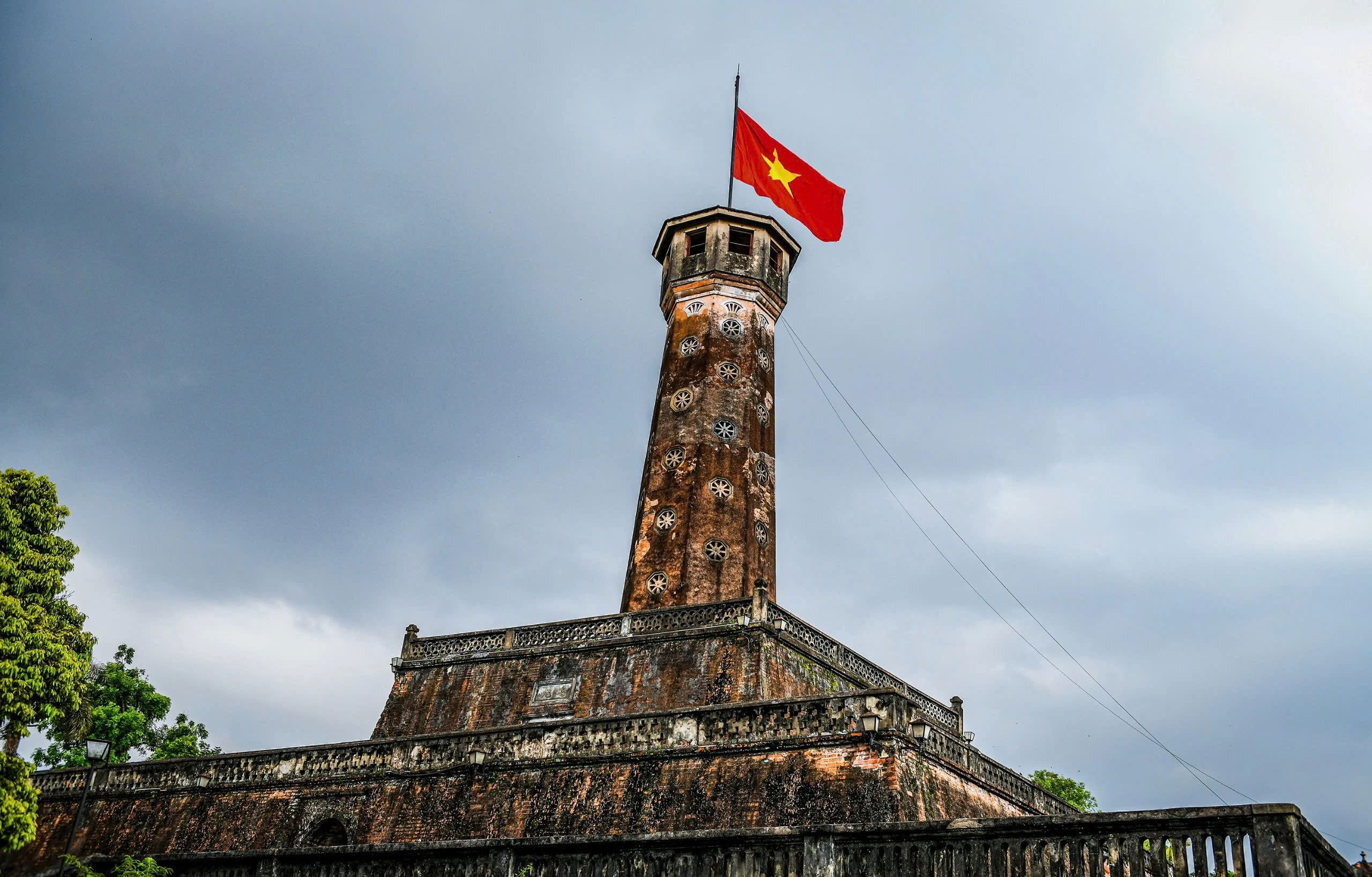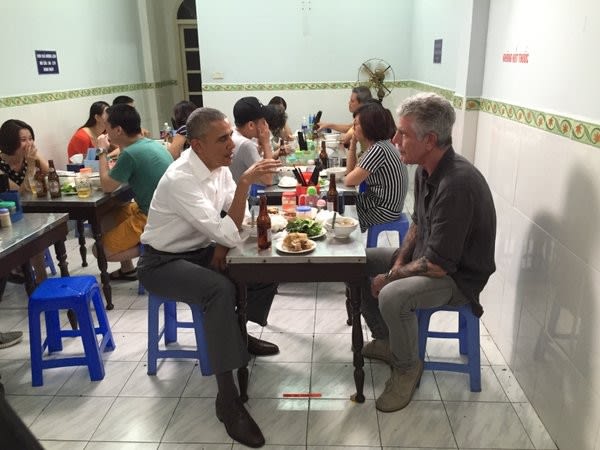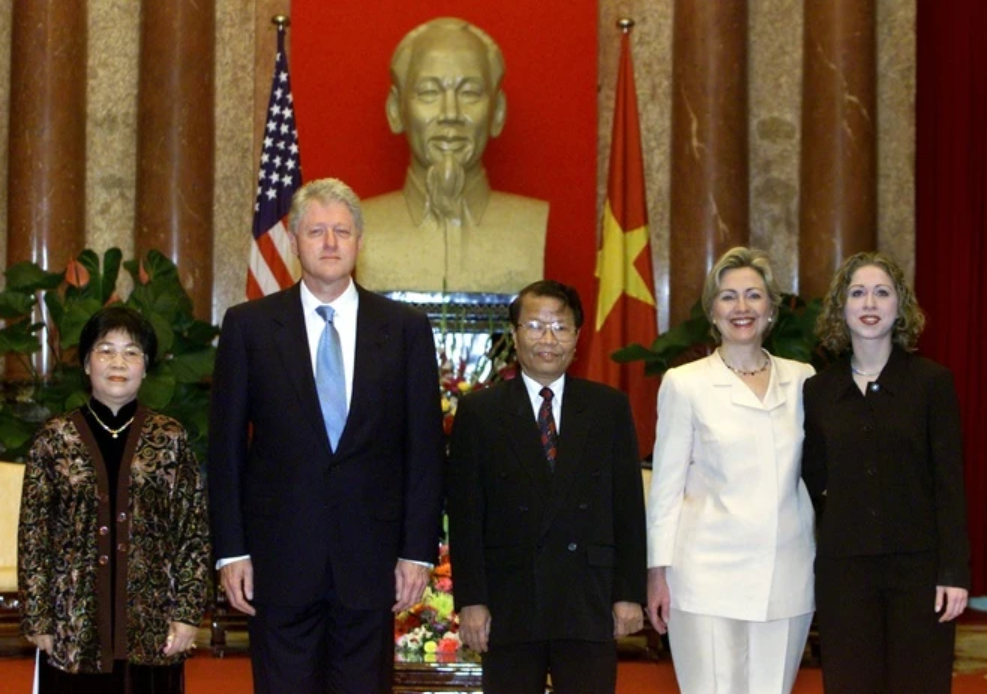FROM A CITY FOR PEACE TO MOVE TOWARDS THE FUTURE
During his visit to Vietnam in May 2016, former US President Barack Obama visited Bun Cha Huong Lien eatery to enjoy ‘bun cha’ (rice noodles with grilled pork) — a famous rustic dish in Vietnam.
The former US President wore a neat shirt and sat on a green plastic chair. Next to him was a low table with two full servings of ‘bun cha’. He leisurely clinked glasses of beer with the late world-famous chef Anthony Bourdain.
The photo was posted by Anthony Bourdain on his Twitter page on the night of May 23. Photo: Twitter/VNA
The photo was posted by Anthony Bourdain on his Twitter page on the night of May 23. Photo: Twitter/VNA
Those images immediately “shocked” the global media, promoting Hanoi that was so peaceful and close. However, for Vietnamese people, the image of a high-ranking leader of a foreign country like Obama visiting, leisurely strolling on the streets of Hanoi, and enjoying cuisine is nothing too new to handle.
Over the past quarter century, taking advantage of the “City for Peace” title, Hanoi is steadily moving towards the future and increasingly positioning itself as a liveable, peaceful and safe city.
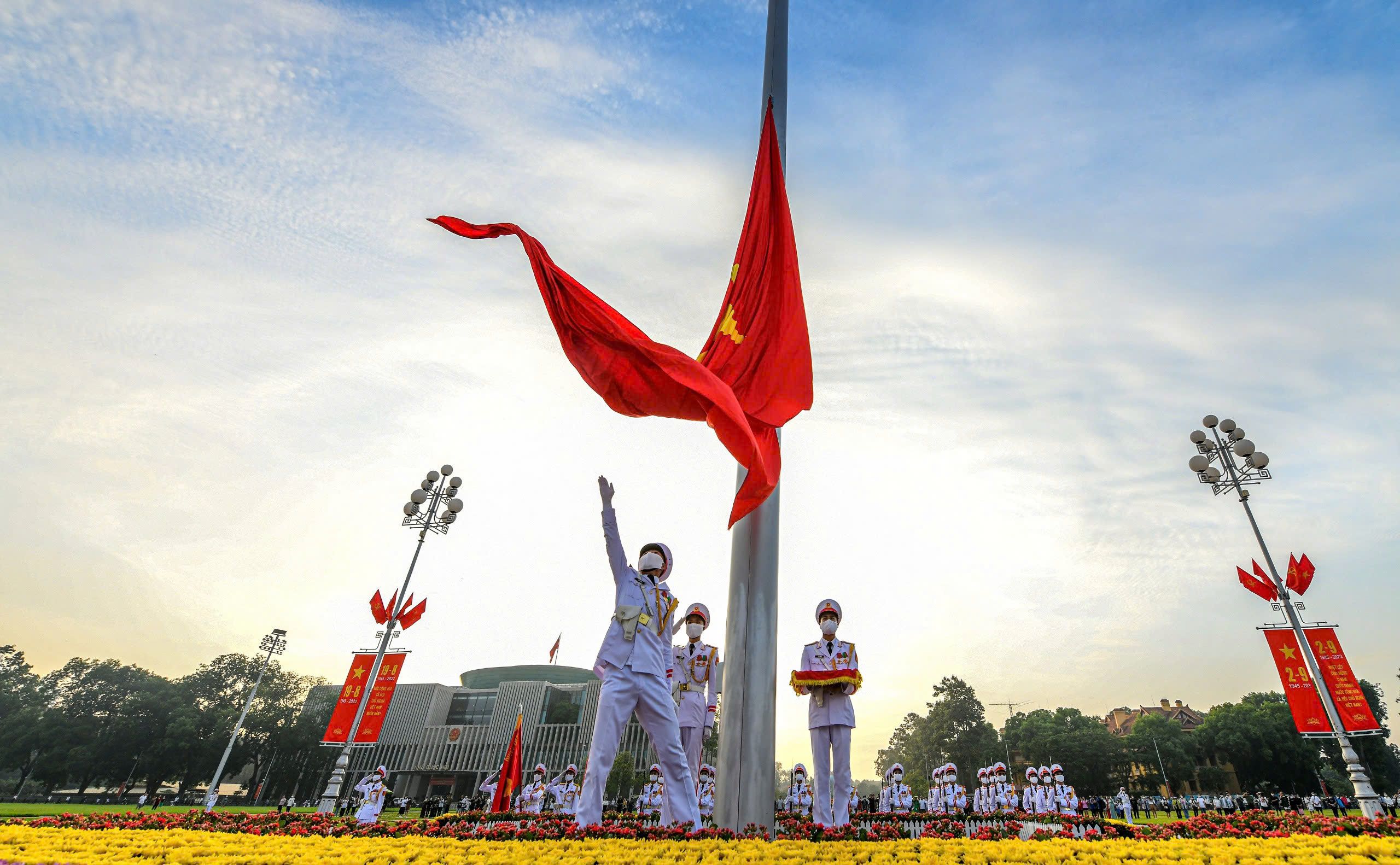
From a peaceful rendezvous of the world

Since 2000, Hanoi has welcomed four US Presidents with five historic visits. No matter who the President is, they are warmly and sincerely welcomed by the people.
Going back further in time, in 1993, a Western head of state came to Vietnam for the first time since 1975 - French President Francois Mitterrand also walked around Hanoi's Old Quarter without being separated by too many guards.
25 years after the end of the war, US President Bill Clinton visited Hanoi. This event was even more meaningful because it was US President Bill Clinton who declared the lifting of the trade embargo against Vietnam, which paved the way for the normalisation of relations in 1995, and the signing of the Bilateral Trade Agreement.
Bill Clinton was the one who declared the lifting of the trade embargo against Vietnam, which paved the way for the normalisation of relations in 1995, and the signing of the Bilateral Trade Agreement. During his first visit to Vietnam, Clinton was accompanied by First Lady Hillary Clinton and their daughter Chelsea. (Photo: Reuters)
Bill Clinton was the one who declared the lifting of the trade embargo against Vietnam, which paved the way for the normalisation of relations in 1995, and the signing of the Bilateral Trade Agreement. During his first visit to Vietnam, Clinton was accompanied by First Lady Hillary Clinton and their daughter Chelsea. (Photo: Reuters)
After high-level meetings with leaders of the Vietnamese Party and State, US President Bill Clinton said he wanted to visit some places to learn about the culture and customs of Hanoi and Vietnam. The chosen places included the Temple of Literature - Quoc Tu Giam, and the Vietnam National University - Hanoi.
The image of the US President comfortably and leisurely walking to Khue Van Cac (Constellation of Literature Pavilion) in the warm welcome of the Vietnamese people created good impressions for participants at the event.
Not only the US Presidents, but the heads of state of other countries also felt the peace while visiting Hanoi. Those who love the city for peace, the heart of Vietnam, have recorded the "excursions" of international politicians around Hanoi. They included the Australian Prime Minister, the Canadian Prime Minister jogging at Hoan Kiem Lake, comfortably walking and having fun at tourist, cultural and street spots in Vietnam.
No one could forget the journey through the “heart of Hanoi” made by Prince William of the United Kingdom and the Duke of Cambridge in 2016. He stopped at a small street-side coffee shop on Thuoc Bac Street, where he had a warm conversation with singer Hong Nhung, musician Thanh Bui, and actor Xuan Bac before continuing his walk to Ngoc Son Temple.
Hoan Kiem Lake and surrounding areas. (Photo: DUY LINH)
Hoan Kiem Lake and surrounding areas. (Photo: DUY LINH)
In the same year, a video of the Hanoi tour by the Ambassadors of the European Union, France, the UK, and Romania went viral across social media platforms worldwide. The clip began with the EU Ambassador to Vietnam, Bruno Angelet, the UK Ambassador, Giles Lever, the French Ambassador, Jean-Noel Poirier, and the Romanian Ambassador, Valeriu Arteni, sitting together, warmly enjoying steaming bowls of pho. Then, it showed these senior European leaders walking along the streets, stopping by flower vendors to select lilies and peach blossoms and haggling over prices with local sellers.
In mid-April 2023, US Secretary of State Antony Blinken made his first visit to Vietnam as the head of US diplomacy. The visit took place in the context of the 10th anniversary of the establishment of the Comprehensive Partnership between the US and Vietnam.
Despite his packed schedule, on the evening of April 15, Blinken had some time to relax, strolling and dining in Hanoi. He visited the Binh Minh Jazz Club at No. 1 Trang Tien Street, enjoying music with an old friend, former Vietnamese Deputy Minister of Foreign Affairs Pham Quang Vinh.
Afterwards, he and his colleagues had dinner at Com Tay Cam, a restaurant in a small alley near the Hanoi Opera House, Trang Tien Alley. A local menu featuring dishes like shrimp spring rolls, white rice, and shrimp simmered in coconut water was chosen and ordered in advance by Blinken himself. He also added more dishes when dining at the restaurant.
Ho Tay (West Lake) area. Photo: DUY LINH
Ho Tay (West Lake) area. Photo: DUY LINH
Later, Blinken shared his experience on Twitter, writing: “You can’t visit Vietnam and not sample the food. Vietnamese cuisine has some of the freshest flavours, and we see its influence across the US in our restaurants. Thank you to Com Tay Cam for allowing me to sample your incredible food…” He even added a comment in Vietnamese: “Quá ngon! (So delicious!)”
Most recently, Dutch Prime Minister Mark Rutte, during his third visit to Vietnam on November 1-2, 2023, had a special journey with Prime Minister Pham Minh Chinh around the streets of Hanoi. Despite a busy schedule, the two leaders took time to ride bicycles together to experience the beauty of Hanoi's autumn and to share important messages.
According to Nguyen Thi Ngoc Thanh, Chairwoman of the Hanoi Peace Committee, the peaceful environment, political stability, and friendly people have long made Hanoi a prime location for hosting major international events such as the APEC Summit, the 2nd US - Democratic People’s Republic of Korea (DPRK) Summit, and the General Assembly of the Inter-Parliamentary Union.
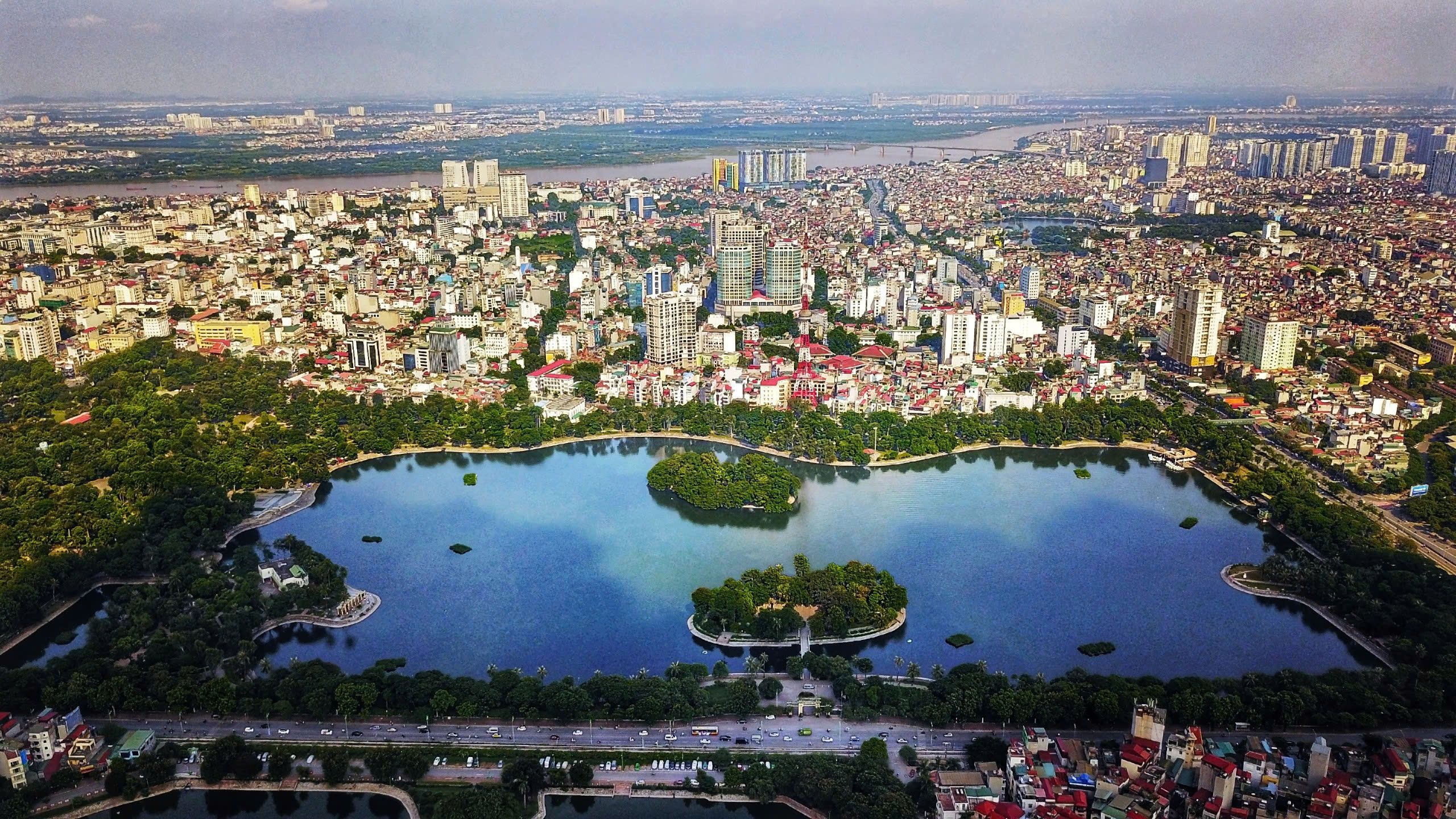
To an inspiring city and global destination

Dao Quyen Truong, Deputy Director of the Department for Cultural Diplomacy and UNESCO under the Ministry of Foreign Affairs stated that possessing UNESCO titles is not only the recognition of a locality or country’s cultural, historical and natural values but also an important component forming the brand of each country and locality.
He emphasised that this title also makes important contributions to socio-economic development by drawing visitors, changing the economic structure, and fostering the green and sustainable growth model.
For Hanoi, the title enhances the position and reputation of Hanoi in particular and Vietnam in general in the region and on the international stage, promoting Hanoi to the world, thereby strengthening friendship and international cooperation with other countries.
A corner of Hanoi. (Photo: Thanh Dat)
A corner of Hanoi. (Photo: Thanh Dat)
In fact, since receiving this title, Hanoi has implemented many projects on culture, traditional education and environmental protection. Many goals, programmes and projects have been completed, promoting socio-economic development and improving people’s living standards.
Thanks to such efforts, a series of projects have been completed in the past 25 years, especially since Hanoi’s geographical boundary was expanded, including Thanh Tri Bridge, Vinh Tuy Bridge, Thang Long Boulevard, Nhat Tan Bridge, Vinh Thinh Bridge, the 3rd Ring Road, the 2nd Ring Road, Hanoi-Hai Phong Expressway, Hanoi-Thai Nguyen Expressway, Noi Bai International Airport’s T2 Terminal and the Cat Linh-Ha Dong metro line.
The capital, Hanoi, has also become increasingly civilised and modern. Hanoi is not only the country’s political, cultural and economic centre but also the centre of international exchange. According to Tran Nghia Hoa, Deputy Director of the Hanoi Department of External Affairs, Hanoi currently has relationships with 100 cities and capitals of countries in the world. Among them, Hanoi has signed cooperation agreements with 61 capitals and cities, has economic and trade relations with nearly 200 countries and territories, and is an active member of many prestigious international organisations.
Hanoi has signed cooperation agreements with 61 capitals and cities, has economic and trade relations with nearly 200 countries and territories, and is an active member of many prestigious international organisations.
Regarding tourism, international arrivals to Hanoi have been increasing over the years. According to the Hanoi Department of Tourism, the total number of visitors to Hanoi in 2023 reached 24.73 million, up 30.93% compared to 2022. The figure for the first six months of 2024 was 13.92 million, up 12.7% over the same period last year.
Among visitors to Hanoi, the number of foreign visitors in 2023 was 4.72 million, a 2.8-fold increase from 2022. The figure is even more impressive in the first half of 2024 at 3 million, up 50% year on year.
The number of international visitors to Hanoi has also increased continuously every year. Photo: THANH DAT
The number of international visitors to Hanoi has also increased continuously every year. Photo: THANH DAT
Notably, the total revenue from tourists in the above periods has also increased continuously. The position and reputation of the capital's tourism in the international arena are increasingly affirmed and enhanced. From 2023 to 2024, Hanoi continues to be highly appreciated by prestigious travel magazines and websites for its attractiveness. Typical titles include Asia's leading city tourism destination in 2023, Asia's leading city tourism destination for short breaks in 2023, and Asia's leading city tourism management agency. Hanoi is also in the top 10 most beautiful destinations in Southeast Asia, top 17 in the list of 25 famous places to travel globally and top 3/20 in the list of destinations for world food lovers.
“The above figures represent the impressive growth of the capital, Hanoi has been and is being known not only as a dynamic, modern city but also as an attractive cultural destination, a place that preserves precious traditional values,” Dr Dao Quyen Truong emphasised.
Hanoi has been and is being known not only as a dynamic, modern city but also as an attractive cultural destination, and a place that preserves precious traditional values.
More specifically, in the eyes of international visitors, Hanoi from the city of Peace and for Peace has become a model and an inspirational symbol.
Ms Jane Runkat - Charge d’Affaires of the Indonesian Embassy, shared: Hanoi has turned historical difficulties into today’s competitiveness, becoming a centre of education, science, technology and culture in the region. Hanoi's efforts in sustainable development also demonstrate that the capital is worthy of the title, with many initiatives to address environmental challenges.
“The recognition of Hanoi as a UNESCO City for Peace can inspire other cities to pursue the path of peace and development,” said Jane Runkat.

Steady steps towards the future

In recent years, Hanoi has adopted many programs and plans, especially Programme 06-CTr/TU of the City Party Committee for the 2020-2025 term on Cultural Development, Improving the Quality of Human Resources, Building Elegant and Civilised Hanoians; Programme No. 08-CTr/TU on Developing the Social Security System, Improving Social Welfare, Quality of Life of the Capital’s People. The Party Committee, government and people of the city have made efforts to continue improving the quality of life of the people in all aspects: Environment, education, and culture.
With Programme No.08, the city allocates resources to care for vulnerable groups in society. Poor and near-poor households are supported to build houses through the activities of social organisations and receive preferential loans to develop production and vocational training. Thanks to that, by the end of 2023, the city only had 690 poor households, accounting for 0.03%, and 15,835 near-poor households, accounting for 0.7% of the total number of households. Currently, 16 districts of the city have no more poor households. The city continues to implement measures to prevent re-poverty and re-near-poverty.
The city strives to improve the quality of life of its people. Photo: TRAN HAI
The city strives to improve the quality of life of its people. Photo: TRAN HAI
In parallel, activities to promote cultural and educational development, care for civic education and the young generation are being deployed in conjunction with the implementation of Programme 06. Hundreds of relics in the city have been invested in restoration and embellishment. Implementing the resolution of the City People's Council, Hanoi decided to allocate 14,029 billion VND to invest in the restoration and embellishment of 579 relics in the 2021-2025 period. This attention not only helps with the restoration of the capital's outstanding relics, such as: Thang Long Imperial Citadel, Van Mieu - Quoc Tu Giam (The Temple of Literature), Tran Quoc Pagoda, Thay Pagoda, and Duong Lam Ancient Village, but also helps relics in remote areas regain their ancient beauty.
Notably, exactly 20 years after achieving the title "City for Peace", in October 2019, Hanoi continues to be honoured as a member of the "UNESCO Creative Cities Network", with the view of taking cultural resources and cultural creativity as the foundation for sustainable urban development. This is an affirmation of the achievements that Hanoi has achieved in preserving and developing the criteria of the "City for Peace".
Good traditional values are the foundation for the new system of Vietnamese human values. Photo: THANH GIANG
Good traditional values are the foundation for the new system of Vietnamese human values. Photo: THANH GIANG
In his speech at the high-level seminar titled "Consultation on initiative: Hanoi - Creative City", Michael Croft, Chief Representative of UNESCO in Vietnam, said that becoming a creative city helped increase its position besides the title “City for Peace”.
In the five years since joining the network, Hanoi has initially turned culture into a pillar in its local development plan and actively cooperated at the international level, organising many activities to realise its commitments to UNESCO.
Many mechanisms, policies and plans have been issued by the city to build and develop a "Creative City" such as the City Party Committee’s Resolution No. 09-NQ/TU on "Developing of Cultural Industries in the Capital City from 2021-2025, with orientation towards 2030 and vision towards 2045”, and Plan No. 102/KH-UBND on implementing initiatives to participate in the UNESCO Creative Cities Network by 2025.
Hanoi is the first locality in the country to have a separate Resolution on developing cultural industries. Photo: THANH DAT
Hanoi is the first locality in the country to have a separate Resolution on developing cultural industries. Photo: THANH DAT
The city has promoted the development of creative cultural spaces, creating identity and attractiveness for the city, inspiring creativity for the community and regenerating the city. Currently, Hanoi has about 60 creative spaces, including seven co-working spaces and 42 cultural-artistic spaces, creative cultural spaces on walking streets, Phung Hung mural space, the Quintessence of Vietnamese Craft Villages space, the Hanoi Museum cultural architecture space, and the walking space around Van Mieu - Quoc Tu Giam.
"From a City for Peace to a Creative City is not just about gaining another proud title, but it is a driving force for the Capital City to resolutely transform its growth model, aiming for sustainability and fostering the creativity of those dedicated to the city," said Nguyen Thi Ngoc Thanh, Chairwoman of the Hanoi Peace Committee.
From “City for Peace” to “Creative City”. This is not simply another title to be proud of, but also a driving force for the capital to be determined to transform the growth model, towards sustainability, promoting the creativity of people dedicated to the capital.

Three solution groups to promote the value of UNESCO titles
According to Dr Dao Quyen Truong, a member of the Secretariat of the Vietnam National Commission for UNESCO, enhancing the value of UNESCO titles is not only a responsibility for preservation but also a critical leverage for promoting Hanoi’s sustainable development.
“This is an urgent and challenging task that requires the cooperation of the entire society, from local authorities, organisations, and businesses to each citizen of the Capital,” said the Deputy Director of the Department of Cultural Diplomacy and UNESCO (under the Ministry of Foreign Affairs).
Dr Dao Quyen Truong proposed three groups of solutions that the National Commission for UNESCO will work on with Hanoi in the near future:
Firstly, it is crucial to strengthen the preservation and promotion of heritages by preserving and restoring historical and cultural relic sites to ensure their integrity and value. This includes developing and implementing environmental protection programmes within heritage areas while minimising negative impacts from business activities and residents' daily lives on the heritage.
Research should focus on regularly organising traditional festivals, art performances, creative competitions, and exhibitions to introduce and promote heritage values to the public.
Additionally, it is essential to organise classes, training programmes, exchanges, and interactive sessions to teach traditional art forms to the younger generations to ensure continuity and development. Increasing public education efforts, particularly aimed at the younger generation, about the value of heritage is also vital.
Secondly, it is crucial to focus on linking heritages with tourism development by creating unique tourism products and exploring ways to combine UNESCO titles to develop diverse and distinctive tourism experiences that offer enjoyment and education. In particular, various media channels should be utilised to promote Hanoi's heritage image to domestic and international tourists.
Thirdly , resource mobilisation and investment attraction from domestic and international sources should be promoted. Private sector involvement is encouraged in heritage conservation and promotion projects.
Published: October 2024
Production manager: PHAM TRUONG SON
Content: SON BACH, MINH KHOI
Design: NGO HUONG
Photos: THANH DAT, DUY LINH, THANH GIANG, VNA
